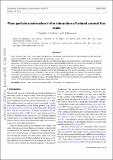Files in this item
Flare particle acceleration in the interaction of twisted coronal flux ropes
Item metadata
| dc.contributor.author | Threlfall, J. | |
| dc.contributor.author | Hood, A. W. | |
| dc.contributor.author | Browning, P. K. | |
| dc.date.accessioned | 2018-01-29T11:30:08Z | |
| dc.date.available | 2018-01-29T11:30:08Z | |
| dc.date.issued | 2018-03-20 | |
| dc.identifier | 252128978 | |
| dc.identifier | cd2cc741-e2b6-4a86-8924-c59b2bdaeab5 | |
| dc.identifier | 85044273430 | |
| dc.identifier | 000427921100003 | |
| dc.identifier.citation | Threlfall , J , Hood , A W & Browning , P K 2018 , ' Flare particle acceleration in the interaction of twisted coronal flux ropes ' , Astronomy & Astrophysics , vol. 611 , A40 . https://doi.org/10.1051/0004-6361/201731915 | en |
| dc.identifier.issn | 0004-6361 | |
| dc.identifier.other | BibCode: 2018arXiv180102907T | |
| dc.identifier.other | BibCode: 2018A&A...611A..40T | |
| dc.identifier.other | ORCID: /0000-0003-2620-2068/work/58055205 | |
| dc.identifier.uri | https://hdl.handle.net/10023/12627 | |
| dc.description | The authors gratefully acknowledge the support of the U.K. Science and Technology Facilities Council. JT and AWH acknowledge the financial support of STFC through the Consolidated grant, ST/N000609/1, to the University of St Andrews. PKB acknowledges STFC support through ST/P000428/1 at the University of Manchester. | en |
| dc.description.abstract | Aims. The aim of this work is to investigate and characterise non-thermal particle behaviour in a three-dimensional (3D) magnetohydrodynamical (MHD) model of unstable multi-threaded flaring coronal loops. Methods. We have used a numerical scheme which solves the relativistic guiding centre approximation to study the motion of electrons and protons. The scheme uses snapshots from high resolution numerical MHD simulations of coronal loops containing two threads, where a single thread becomes unstable and (in one case) destabilises and merges with an additional thread. Results. The particle responses to the reconnection and fragmentation in MHD simulations of two loop threads are examined in detail. We illustrate the role played by uniform background resistivity and distinguish this from the role of anomalous resistivity using orbits in an MHD simulation where only one thread becomes unstable without destabilising further loop threads. We examine the (scalable) orbit energy gains and final positions recovered at different stages of a second MHD simulation wherein a secondary loop thread is destabilised by (and merges with) the first thread. We compare these results with other theoretical particle acceleration models in the context of observed energetic particle populations during solar flares. | |
| dc.format.extent | 7561225 | |
| dc.language.iso | eng | |
| dc.relation.ispartof | Astronomy & Astrophysics | en |
| dc.subject | Plasmas | en |
| dc.subject | Sun: corona | en |
| dc.subject | Sun: magnetic fields | en |
| dc.subject | Sun: activity | en |
| dc.subject | Acceleration of particles | en |
| dc.subject | QB Astronomy | en |
| dc.subject | QC Physics | en |
| dc.subject | 3rd-NDAS | en |
| dc.subject.lcc | QB | en |
| dc.subject.lcc | QC | en |
| dc.title | Flare particle acceleration in the interaction of twisted coronal flux ropes | en |
| dc.type | Journal article | en |
| dc.contributor.sponsor | Science & Technology Facilities Council | en |
| dc.contributor.sponsor | Science & Technology Facilities Council | en |
| dc.contributor.institution | University of St Andrews. Applied Mathematics | en |
| dc.identifier.doi | 10.1051/0004-6361/201731915 | |
| dc.description.status | Peer reviewed | en |
| dc.identifier.url | http://adsabs.harvard.edu/abs/2018arXiv180102907T | en |
| dc.identifier.url | https://arxiv.org/abs/1801.02907 | en |
| dc.identifier.grantnumber | ST/L005522/1 | en |
| dc.identifier.grantnumber | ST/N000609/1 | en |
This item appears in the following Collection(s)
Items in the St Andrews Research Repository are protected by copyright, with all rights reserved, unless otherwise indicated.

